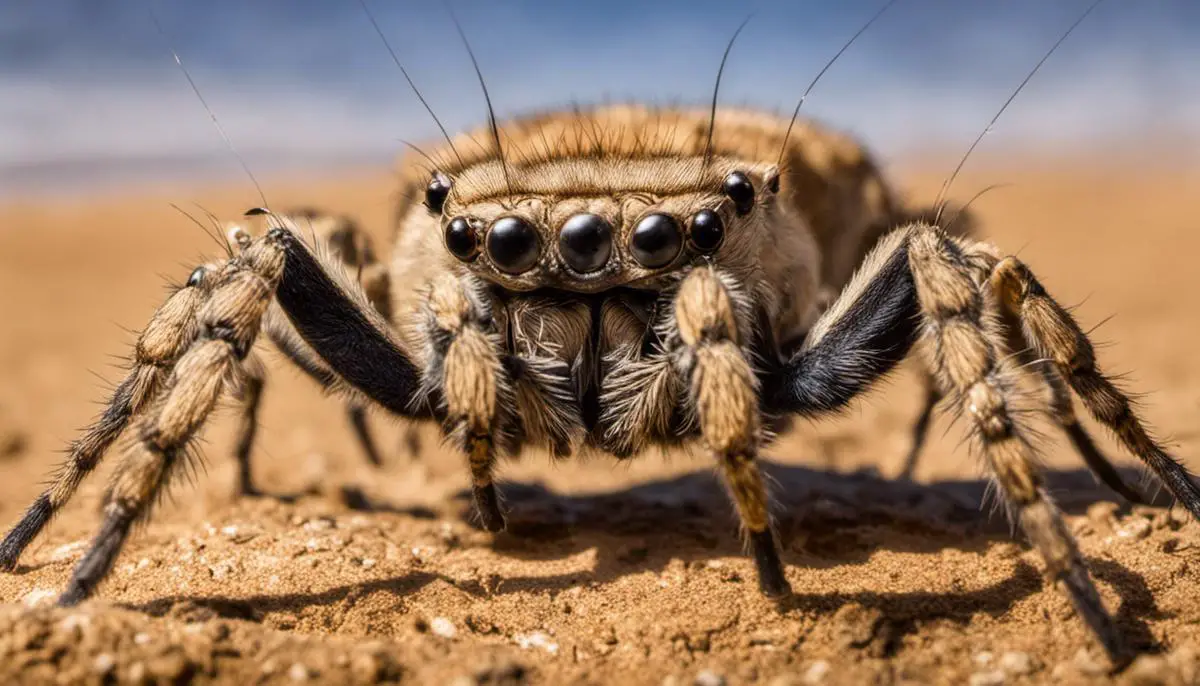Understanding Camel Spider Size: A Comparative Study
In the intricate world of arachnids, the camel spider, or Solifugae, stands as an impressive outlier within its taxonomical family. These creatures, infamous for their substantial size and menacing appearance, are enshrouded in lore, largely depicting them as colossal, desert-dwelling beasts.
With roots stemming deep into the realm of natural history, their hint of mystery has fueled many a misunderstanding about their real size and features. This investigation delves into the realm of camel spiders, detailing their unique anatomical attributes, analyzing the size range across various species, and drawing comparisons with other members of the arachnid phylum.
The aim of this research is to delve beyond public misconceptions, scrutinizing the factors influencing the size of these intriguing creatures, and accurately documenting camel spiders within their rightful context of the arachnid world.
Scientific Classification and Anatomical Description of Camel Spiders
Taxonomical Background of Camel Spiders
Camel spiders, scientifically referred to as Solifugae, belong to the Arachnida class which also includes spiders, scorpions, and ticks among other species. Despite their name, they are neither spiders nor scorpions although they share certain characteristics with both groups. This group of arachnids comprises over a thousand described species that are mainly found in arid regions around the world.
Evolutionary History of Solifugae
The evolutionary history of Solifugae can be traced back to the Silurian period (about 444 to 419 million years ago), with their ancient ancestors thought to have emerged before the adaptation of insects to terrestrial life. Their large size, when compared to the minute members of the arachnid class, is a significant factor in their successful adaptation to arid conditions, resulting in a resilient survival rate across millions of years.
Anatomical Structure Linking to Size
Camel spiders are known for their large size in comparison to other arachnid species, with some of the largest species measuring up to 15cm in body length. The most prominent feature contributing to their size is the pair of large, muscular chelicerae. These have numerous functions including serving as a primary organ for feeding, defence, courtship, and burrow excavation.
Their unique external anatomy also displays long, thin appendages called pedipalps. On average, pedipalps are at least as long as the camel spider’s body, acting like a pair of feelers. These long, hair-like pedipalps, in addition to four pairs of legs, also contribute to their perceived size. While the first pair of legs is often mistaken for an additional pair of pedipalps due to their tactile nature, the other three pairs enable rapid movement across sandy substrates.
Size Variation Among Camel Spiders
While camel spiders are generally large compared to other arachnids, they still display considerable size variation within their taxonomic group. The size of camel spiders can range anywhere from 0.5 cm to 15 cm in length, excluding leg and chelicerae measurements. This variation is generally driven by specific adaptive features that have evolved in accordance with the environmental constraints of their habitats.
Size Misconceptions
Despite the large size of some camel spider species, there is a widespread misconception, exacerbated by alarming internet images, that they are much larger than they actually are. Images often show close-up shots, which create the illusion that these creatures are larger than is truly the case. Furthermore, the unusually large chelicerae and long legs can give a misleading impression of the overall body size of a camel spider.
Are Camel Spiders Dangerous or Simply Fascinating?
In spite of their rather intimidating size and unnerving appearance, camel spiders, for the most part, present no substantial threat to humans. The most menacing aspect of them to us can be a painful bite, which is, by and large, not harmful. The ecological significance of these arachnids is considerably more noteworthy, as they play key roles in desert ecosystems, feeding on a variety of pests. While their impressive size, particularly when compared to many of their arachnid relatives, does make them intriguing, it’s their unusual biology and ecological contributions that truly make them a subject of interest, rather than any potential threat they pose.

Analyzing the Size Spectrum of Camel Spiders
The Size of Camel Spiders in Comparison with Other Species
Camel spiders, otherwise known as wind scorpions, are one of the largest members of the arachnid family. They’re part of the Solifugae order, comprising roughly a thousand distinct species divided across multiple families. A typical camel spider can measure anywhere between 1.2 inches (3 cm) and 6 inches (15 cm) if you include their legs and substantial chelicerae, both integral to their overall size. Yet, the principal body length of most species of camel spiders tends to be relatively small, with the average species boasting a length close to 4 inches (10 cm).
When you put them side by side with other arachnid species, the size of camel spiders puts them close to the top of the heap. As an example, the largest species of spider, such as the Goliath Birdeater or the Huntsman spider, can span up to 12 inches (30 cm), and this measurement includes their leg span. Nonetheless, it’s the large chelicerae and formidable body mass of the camel spider that truly set them apart as one of the largest and most intimidating of the non-venomous arachnids.
Geographical Distribution and Size Variation
Size variation in camel spiders is largely dependent on their geographical location. The largest species, reaching up to 6 inches (15 cm), are predominantly found in the Middle East and African desert regions. These spiders have evolved to be larger in these regions due to the availability of larger prey and fewer predators. In comparison, those found in the United States and Mexico are generally smaller, usually no more than 3 inches (7.5 cm) in length.
Influence of Environmental Factors and Breeding Behaviours
The size of camel spiders is significantly influenced by environmental factors. During the dry season, when food is scarce, the size of these arachnids may significantly decrease due to malnutrition. On the other hand, in the wet season, when there is an abundance in the food supply, camel spiders grow to their maximum potential size.
Furthermore, the breeding behaviours of camel spiders also play a role in their size. Females are typically larger than males, a phenomenon known as sexual dimorphism. This is because larger female camel spiders are more successful at producing more offspring, thus driving the evolution of larger females in many camel spider species.
Common Misconceptions about Camel Spider Size
The size of camel spiders has often been exaggerated, contributing to various misconceptions about these creatures. Pictures circulating online portraying them to be the size of a human calf or arm, which are often the result of forced perspective photography. In actuality, the largest scientifically recorded camel spider measures 6 inches (15 cm) inclusive of their leg span.
These misconceptions have played a significant role in creating an unfounded fear around these animals, enhancing their perception as giant arachnids. However, while they are relatively large when compared to many other arachnid species, they are, in reality, far from the monstrous sizes often portrayed in common mythology.
The Role of Genetics in Determining Size
In the world of camel spiders, genetics play a vital role in defining their size. Similar to other members of the Arachnids, these creatures’ size is primarily determined by their genetic composition. Each species has an innate size range that is obtainable based on its genetic structure. However, the actual size of an individual spider can be larger or smaller than the stipulated average size for species due to factors like environmental influences and internal genetic variations within the species.
Current research focuses on uncovering the genetic signposts and processes that govern the size of a camel spider. Through this, scientists aim to further comprehend the dynamics behind their size regulation.

Comparative Analysis of Camel Spider Size to Other Arachnids
An Insight into Camel Spider Size Comparison
Known scientifically as Solifugae, Camel Spiders are intriguing members of the Arachnid class that have often been subject to a myriad of misinterpretations, one of which revolves around their size. Although a few of them can grow impressively large, the average camel spider usually measures around 5 to 6 inches in length. This figure incorporates both their imposing body and long legs.
Camel Spiders Versus True Spiders
True spiders, those that belong to the order Araneae, vary significantly in size. The smallest spiders, like the Patu digua from Colombia, measure merely less than 0.015 inches, while the largest spiders, such as the Goliath bird-eating spider, can reach sizes of up to 11 inches, including leg span. Comparatively, the size of the camel spider falls towards the larger spectrum of spider sizes but is notably less than the maximum.
Size Comparison: Camel Spiders and Scorpions
Scorpions, the order Scorpiones within the class Arachnida, possess sizes that range widely. Small species like Microtityus minimus merely measure about half an inch, while large types such as the African Emperor Scorpion can grow up to 7.9 inches long. As such, camel spiders can be somewhat smaller or larger than different scorpion species, and their size places them approximately in the middle of the scorpion size range.
Camel Spiders Versus Ticks
Ticks, acarids belonging to the order Ixodida, are generally much smaller than camel spiders. Most ticks measure between 0.1 to 0.2 inches in length, while larger species can grow to approximately 0.5 inches in length when engorged with blood. In comparison, camel spiders are significantly larger.
Factors influencing Size
The size of these creatures is influenced by a combination of environmental pressures, genetic factors, and dietary requirements. For instance, larger arachnids like camel spiders and some scorpions often live in environments where they have a sufficient food supply, allowing them to grow larger. Genetic factors also play a role, as certain traits, like size, can be hereditary. Lastly, dietary needs can impact size. Camel spiders, in particular, are voracious eaters, and their diet of ground-dwelling insects and other arachnids could contribute to their size.
In conclusion, within the arachnid class, camel spiders are noteworthy not only in their unique structural design but also in their comparatively large size. Their dimensions significantly overtake ticks, moderately align with numerous scorpions, and swing towards the larger spiders, accentuating the intriguing diversity of life forms within this group of creatures.

After examining the unique anatomy of camel spiders, inspection of the demographical size range within the species, and in-depth comparison with other arachnids, a more accurate representation of the fascinating Solifugae has emerged. Even more prominent is the understanding of the role that myriad factors like environment, geographical distribution, breeding, and genetics play in their size variability.
The documented information and analytical comparisons help demystify the hyperbolic notions about their size and present a reality based on factual observations and scientific reasoning. For the unassuming camel spider living in adverse conditions yet showcasing surprising vitality and adaptability, understanding their precise role in the web of life is truly a testament to the varied wonders of the natural world.
